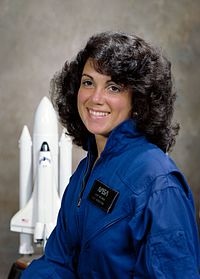Judith Resnik
| Judith Resnik | |
|---|---|

|
|
| Country: | United States |
| Organization: | NASA |
| selected on | January 16, 1978 (8th NASA Group) |
| Calls: | 1, plus STS-51-L |
| Start of the first space flight: |
August 30, 1984 |
| Landing of the last space flight: |
5th September 1984 |
| Time in space: | 6d 0h 57min |
| retired on | January 28, 1986 (accident) |
| Space flights | |
Judith Arlene "Judy" Resnik (born April 5, 1949 in Akron , Ohio ; † January 28, 1986 at Cape Canaveral , Florida ) was an American astronaut who was killed in the Challenger disaster .
Judy was the daughter of Marvin and Sarah Resnik. Her parents were children of Jewish immigrants, her father came to the USA from Ukraine in what was then the Soviet Union when she was about nine years old . The family lived in Jewish traditions, and Resnik also attended a school to learn the Hebrew language. For her civic education, she first attended Fairlawn Elementary in Akron and went to Simon Perkins Junior High School after sixth grade. She graduated from Firestone High School in 1966. Her parents divorced that same year. She then lived for a short time with her father, an optician, until she started her studies.
After her high school graduation attended Resnik, the Carnegie Mellon University in Pittsburgh ( Pennsylvania ), which she left in 1970 with a degree in electrical engineering. She then worked at RCA in Moorestown ( New Jersey ) and later in Springfield ( Virginia ), where she worked on radar systems, sounding rockets and telemetry systems for NASA , among other things .
In 1974 moved Resnik, who was an excellent pianist, to the laboratory for Neurophysiology of the US Food and Drug Administration in Bethesda ( Maryland ). On the side, she wrote at the University of Maryland on her doctoral thesis in electrical engineering, which she completed with her doctorate in 1977. Immediately thereafter, she accepted a position in product development at Xerox , California .
NASA activity
NASA began looking for the first astronauts for the shuttle program in 1976 , with women also being considered for the first time in US space travel. Over 8,000 Americans reported to NASA. The interviews took place at the Johnson Space Center (JSC) in Texas from the summer of 1977 - Resnik was invited in November. She was able to prevail and was presented to the public along with 34 other candidates in January 1978. At 28, she was one of the youngest.
In the spring of 1983 Resnik was selected for her first flight. She was the first Jewish and second American in space when she took off on the space shuttle Discovery in the fall of 1984 . The crew of STS-41-D consisted of the orbit-experienced commander only newcomers. During the week-long flight, three satellites were deployed and solar cells were tested for their space suitability.
Just five months later, Resnik was set up for her second flight as the mission specialist on Challenger flight STS-51-L . In this mission, after a communication satellite of the TDRS series was deployed, Halley's comet , which was near the earth at the time, was to be observed. The SPARTAN satellite was also on board and was to be launched on the third day of the flight. The shuttle took off on January 28, 1986 and broke apart just 73 seconds later. All seven astronauts were killed. (See main article: STS-51-L)
Resnik was divorced and had no children. In honor of the astronaut, a moon crater on the back of the moon and the asteroid (3356) Resnik were named. At times, before the Magellan mission, there was also a crater on the planet Venus named after her based on Soviet Venera data. In addition, a dormitory in her alma mater , a lecture hall at the University of Maryland , an elementary school in Gaithersburg ( Maryland ) and a street in the "Kosmonautenviertel" in Aschersleben, Saxony-Anhalt, bear her name.
Web links
- Short biography of Judith Resnik at spacefacts.de
- NASA biography of Judith Resnik (English; PDF)
- Biography of Judith Resnik in the Encyclopedia Astronautica (English)
- Jewish Women's Archive: Biography (English)
Individual evidence
- ↑ Marvin Resnik, father of Challenger astronaut Judith Resnik, was 90. Cleveland Jewish News, March 18, 2010, accessed on February 22, 2016 (English).
- ↑ The Magellan Venus Explorer's Guide - JPL , accessed November 11, 2018
| personal data | |
|---|---|
| SURNAME | Resnik, Judith |
| ALTERNATIVE NAMES | Resnik, Judy; Resnik, Judith Arlene (full name) |
| BRIEF DESCRIPTION | American astronaut who died in the Space Shuttle Challenger explosion during the launch of mission STS-51-L |
| DATE OF BIRTH | April 5, 1949 |
| PLACE OF BIRTH | Akron , Ohio |
| DATE OF DEATH | January 28, 1986 |
| Place of death | Cape Canaveral , Florida |